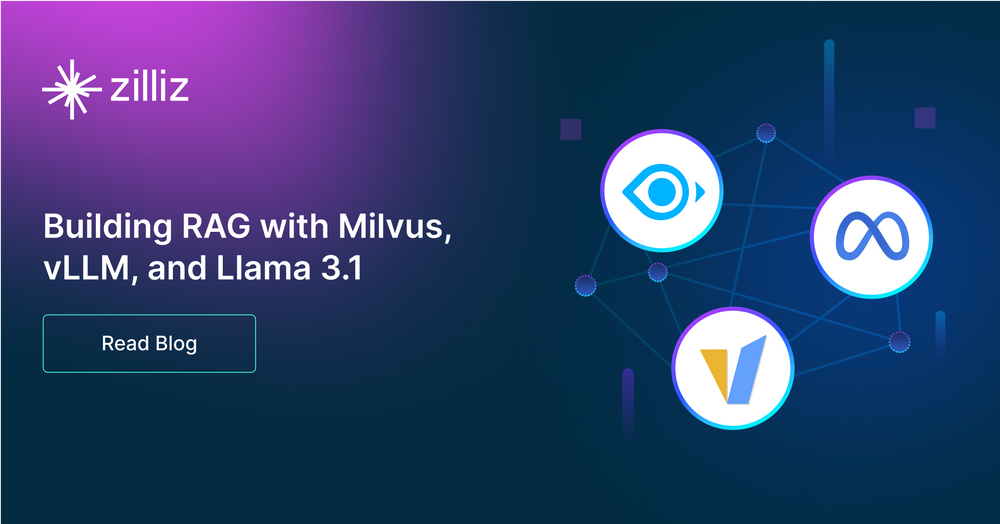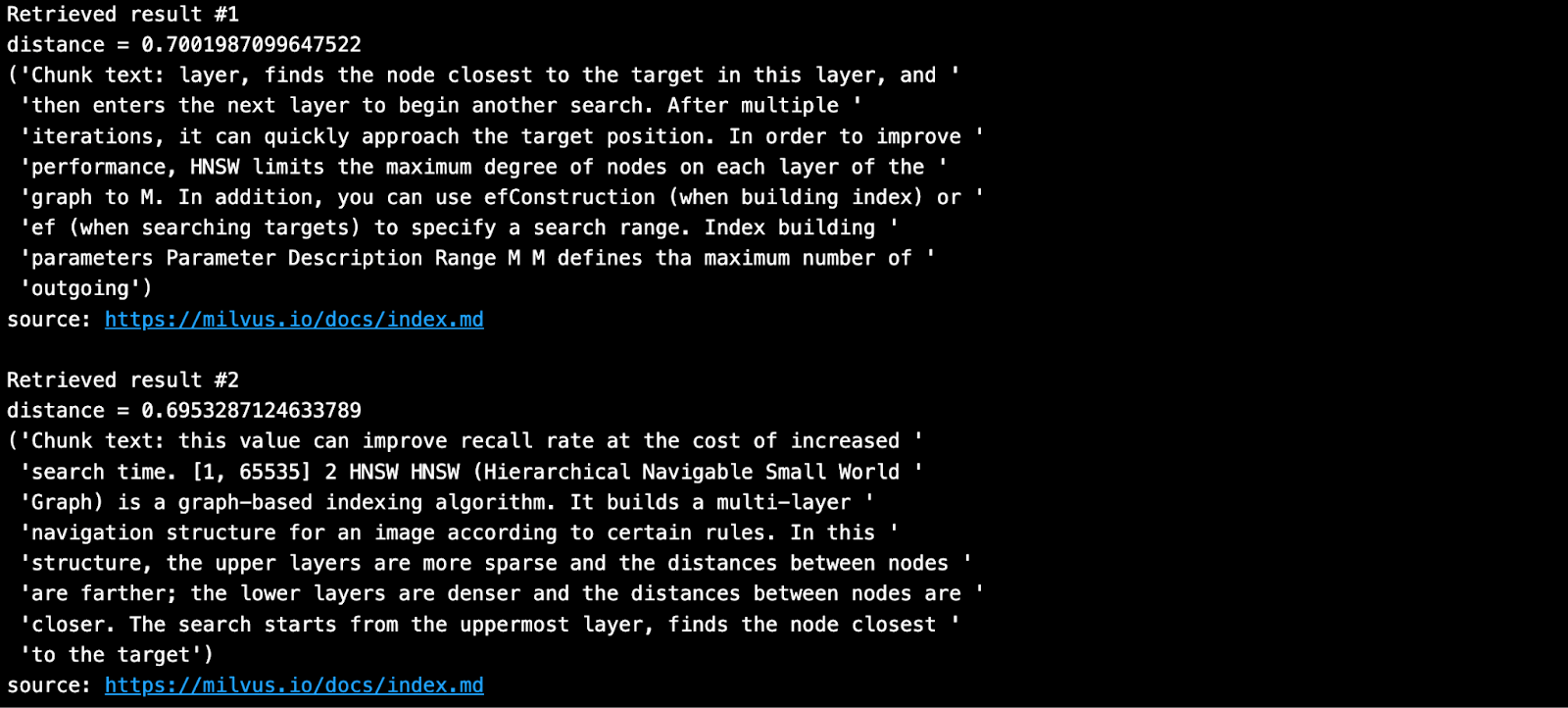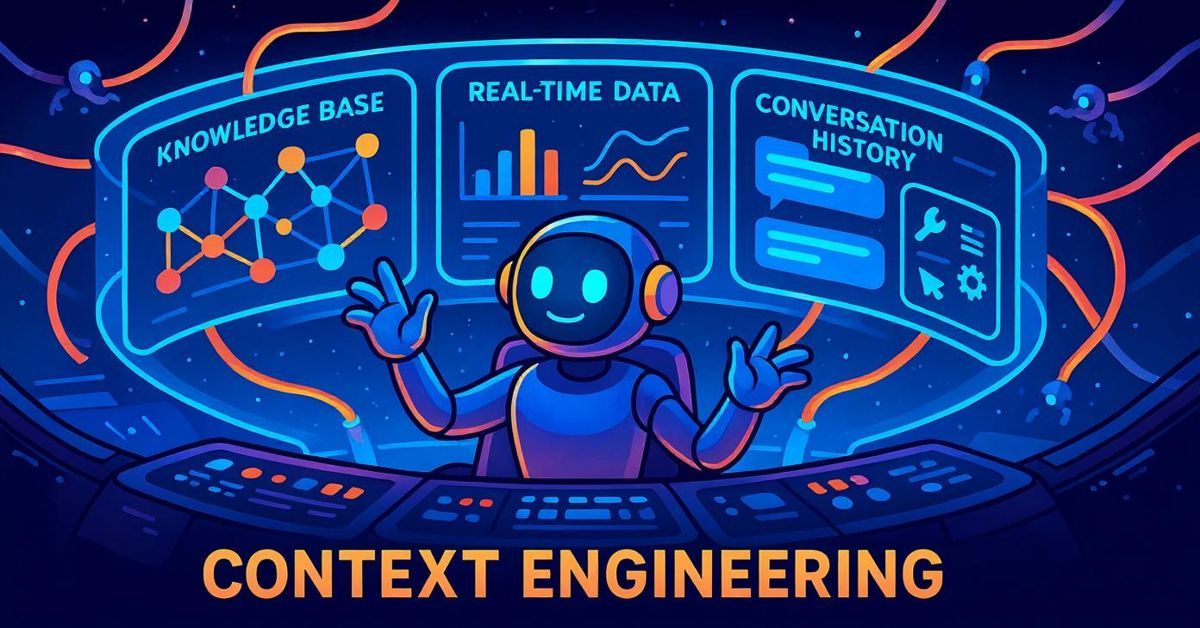Building RAG with Milvus, vLLM, and Llama 3.1

The University of California – Berkeley donated vLLM, a fast and easy-to-use library for LLM inference and serving, to LF AI & Data Foundation as an incubation-stage project in July 2024. As a fellow member project, we’d like to welcome vLLM joining the LF AI & Data family! 🎉
Large Language Models (LLMs) and vector databases are usually paired to build Retrieval Augmented Generation (RAG), a popular AI application architecture to address AI Hallucinations. This blog will show you how to build and run a RAG with Milvus, vLLM, and Llama 3.1. More specifically, I will show you how to embed and store text information as vector embeddings in Milvus and use this vector store as a knowledge base to efficiently retrieve text chunks relevant to user questions. Finally, we'll leverage vLLM to serve Meta's Llama 3.1-8B model to generate answers augmented by the retrieved text. Let's dive in!
Introduction to Milvus, vLLM, and Meta’s Llama 3.1
Milvus vector database
Milvus is an open-source, purpose-built, distributed vector database for storing, indexing, and searching vectors for Generative AI (GenAI) workloads. Its ability to perform hybrid search, metadata filtering, reranking, and efficiently handle trillions of vectors makes Milvus a go-to choice for AI and machine learning workloads. Milvus can be run locally, on a cluster, or hosted in the fully managed Zilliz Cloud.
vLLM
vLLM is an open-source project started at UC Berkeley SkyLab focused on optimizing LLM serving performance. It uses efficient memory management with PagedAttention, continuous batching, and optimized CUDA kernels. Compared to traditional methods, vLLM improves serving performance by up to 24x while cutting GPU memory usage in half.
According to the paper "Efficient Memory Management for Large Language Model Serving with PagedAttention," the KV cache uses around 30% of GPU memory, leading to potential memory issues. The KV cache is stored in contiguous memory, but changing size can cause memory fragmentation, which is inefficient for computation.

Image 1. KV cache memory management in existing systems (2023 Paged Attention paper)
By using virtual memory for the KV cache, vLLM only allocates physical GPU memory as needed, eliminating memory fragmentation and avoiding pre-allocation. In tests, vLLM outperformed HuggingFace Transformers (HF) and Text Generation Inference (TGI), achieving up to 24x higher throughput than HF and 3.5x higher than TGI on NVIDIA A10G and A100 GPUs.

Image 2. Serving throughput when each request asks for three parallel output completions. vLLM achieves 8.5x—15x higher throughput than HF and 3.3x—3.5x higher throughput than TGI (2023 vLLM blog).
Meta’s Llama 3.1
Meta’s Llama 3.1 was announced on July 23, 2024. The 405B model delivers state-of-the-art performance on several public benchmarks and has a context window of 128,000 input tokens with various commercial uses permitted. Alongside the 405-billion parameter model, Meta released an updated version of Llama3 70B (70 billion parameters) and 8B (8 billion parameters). Model weights are available to download on Meta's website.
A key insight was that fine-tuning generated data can boost performance, but poor-quality examples can degrade it. The Llama team worked extensively to identify and remove these bad examples using the model itself, auxiliary models, and other tools.
Build and Perform the RAG-Retrieval with Milvus
Prepare your dataset
I used the official Milvus documentation as my dataset for this demo, which I downloaded and saved locally.
from langchain.document_loaders import DirectoryLoader
# Load HTML files already saved in a local directory
path = "../../RAG/rtdocs_new/"
global_pattern = '*.html'
loader = DirectoryLoader(path=path, glob=global_pattern)
docs = loader.load()
# Print num documents and a preview.
print(f"loaded {len(docs)} documents")
print(docs[0].page_content)
pprint.pprint(docs[0].metadata)
 loaded 22 docs
loaded 22 docs
Download an embedding model
Next, download a free, open-source embedding model from HuggingFace.
import torch
from sentence_transformers import SentenceTransformer
# Initialize torch settings for device-agnostic code.
N_GPU = torch.cuda.device_count()
DEVICE = torch.device('cuda:N_GPU' if torch.cuda.is_available() else 'cpu')
# Download the model from huggingface model hub.
model_name = "BAAI/bge-large-en-v1.5"
encoder = SentenceTransformer(model_name, device=DEVICE)
# Get the model parameters and save for later.
EMBEDDING_DIM = encoder.get_sentence_embedding_dimension()
MAX_SEQ_LENGTH_IN_TOKENS = encoder.get_max_seq_length()
# Inspect model parameters.
print(f"model_name: {model_name}")
print(f"EMBEDDING_DIM: {EMBEDDING_DIM}")
print(f"MAX_SEQ_LENGTH: {MAX_SEQ_LENGTH}")

Chunk and encode your custom data as vectors.
I’ll use a fixed length of 512 characters with 10% overlap.
from langchain.text_splitter import RecursiveCharacterTextSplitter
CHUNK_SIZE = 512
chunk_overlap = np.round(CHUNK_SIZE * 0.10, 0)
print(f"chunk_size: {CHUNK_SIZE}, chunk_overlap: {chunk_overlap}")
# Define the splitter.
child_splitter = RecursiveCharacterTextSplitter(
chunk_size=CHUNK_SIZE,
chunk_overlap=chunk_overlap)
# Chunk the docs.
chunks = child_splitter.split_documents(docs)
print(f"{len(docs)} docs split into {len(chunks)} child documents.")
# Encoder input is doc.page_content as strings.
list_of_strings = [doc.page_content for doc in chunks if hasattr(doc, 'page_content')]
# Embedding inference using HuggingFace encoder.
embeddings = torch.tensor(encoder.encode(list_of_strings))
# Normalize the embeddings.
embeddings = np.array(embeddings / np.linalg.norm(embeddings))
# Milvus expects a list of `numpy.ndarray` of `numpy.float32` numbers.
converted_values = list(map(np.float32, embeddings))
# Create dict_list for Milvus insertion.
dict_list = []
for chunk, vector in zip(chunks, converted_values):
# Assemble embedding vector, original text chunk, metadata.
chunk_dict = {
'chunk': chunk.page_content,
'source': chunk.metadata.get('source', ""),
'vector': vector,
}
dict_list.append(chunk_dict)

Save the vectors in Milvus
Ingest the encoded vector embedding in the Milvus vector database.
# Connect a client to the Milvus Lite server.
from pymilvus import MilvusClient
mc = MilvusClient("milvus_demo.db")
# Create a collection with flexible schema and AUTOINDEX.
COLLECTION_NAME = "MilvusDocs"
mc.create_collection(COLLECTION_NAME,
EMBEDDING_DIM,
consistency_level="Eventually",
auto_id=True,
overwrite=True)
# Insert data into the Milvus collection.
print("Start inserting entities")
start_time = time.time()
mc.insert(
COLLECTION_NAME,
data=dict_list,
progress_bar=True)
end_time = time.time()
print(f"Milvus insert time for {len(dict_list)} vectors: ", end="")
print(f"{round(end_time - start_time, 2)} seconds")

Perform a vector search
Ask a question and search for the nearest neighbor chunks from your knowledge base in Milvus.
SAMPLE_QUESTION = "What do the parameters for HNSW mean?"
# Embed the question using the same encoder.
query_embeddings = torch.tensor(encoder.encode(SAMPLE_QUESTION))
# Normalize embeddings to unit length.
query_embeddings = F.normalize(query_embeddings, p=2, dim=1)
# Convert the embeddings to list of list of np.float32.
query_embeddings = list(map(np.float32, query_embeddings))
# Define metadata fields you can filter on.
OUTPUT_FIELDS = list(dict_list[0].keys())
OUTPUT_FIELDS.remove('vector')
# Define how many top-k results you want to retrieve.
TOP_K = 2
# Run semantic vector search using your query and the vector database.
results = mc.search(
COLLECTION_NAME,
data=query_embeddings,
output_fields=OUTPUT_FIELDS,
limit=TOP_K,
consistency_level="Eventually")
The retrieved result is as shown below.

Build and Perform the RAG-Generation with vLLM and Llama 3.1-8B
Install vLLM and models from HuggingFace
vLLM downloads large language models from HuggingFace by default. In general, anytime you want to use a brand new model on HuggingFace, you should do a pip install—-update or -U. Also, you’ll need a GPU to run inference of Meta’s Llama 3.1 models with vLLM.
For a full list of all vLLM-supported models, see this documentation page.
# (Recommended) Create a new conda environment.
conda create -n myenv python=3.11 -y
conda activate myenv
# Install vLLM with CUDA 12.1.
pip install -U vllm transformers torch
import vllm, torch
from vllm import LLM, SamplingParams
# Clear the GPU memory cache.
torch.cuda.empty_cache()
# Check the GPU.
!nvidia-smi
To learn more about how to install vLLM, see its installation page.
Get a HuggingFace token
Some models on HuggingFace, such as Meta Llama 3.1, require the user to accept their license before being able to download the weights. Therefore, you must create a HuggingFace account, accept the model’s license, and generate a token.
When visiting this Llama3.1 page on HuggingFace, you’ll get a message asking you to agree to the terms. Click “Accept License” to accept Meta terms before downloading model weights. The approval usually takes less than a day.
After you receive approval, you must generate a new HuggingFace token. Your old tokens will not work with the new permissions.
Before installing vLLM, log in to HuggingFace with your new token. Below, I used Colab secrets to store the token.
# Login to HuggingFace using your new token.
from huggingface_hub import login
from google.colab import userdata
hf_token = userdata.get('HF_TOKEN')
login(token = hf_token, add_to_git_credential=True)
Run the RAG-Generation
In the demo, we run Llama-3.1-8B model, which requires GPU and sizable memory to spin up. The following example was run on Google Colab Pro ($10/month) with an A100 GPU. To learn more about how to run vLLM, you can check out the Quickstart documentation.
# 1. Choose a model
MODELTORUN = "meta-llama/Meta-Llama-3.1-8B-Instruct"
# 2. Clear the GPU memory cache, you're going to need it all!
torch.cuda.empty_cache()
# 3. Instantiate a vLLM model instance.
llm = LLM(model=MODELTORUN,
enforce_eager=True,
dtype=torch.bfloat16,
gpu_memory_utilization=0.5,
max_model_len=1000,
seed=415,
max_num_batched_tokens=3000)

Write a prompt using contexts and sources retrieved from Milvus.
# Separate all the context together by space.
contexts_combined = ' '.join(contexts)
# Lance Martin, LangChain, says put the best contexts at the end.
contexts_combined = ' '.join(reversed(contexts))
# Separate all the unique sources together by comma.
source_combined = ' '.join(reversed(list(dict.fromkeys(sources))))
SYSTEM_PROMPT = f"""First, check if the provided Context is relevant to
the user's question. Second, only if the provided Context is strongly relevant, answer the question using the Context. Otherwise, if the Context is not strongly relevant, answer the question without using the Context.
Be clear, concise, relevant. Answer clearly, in fewer than 2 sentences.
Grounding sources: {source_combined}
Context: {contexts_combined}
User's question: {SAMPLE_QUESTION}
"""
prompts = [SYSTEM_PROMPT]
Now, generate an answer using the retrieved chunks and the original question stuffed into the prompt.
# Sampling parameters
sampling_params = SamplingParams(temperature=0.2, top_p=0.95)
# Invoke the vLLM model.
outputs = llm.generate(prompts, sampling_params)
# Print the outputs.
for output in outputs:
prompt = output.prompt
generated_text = output.outputs[0].text
# !r calls repr(), which prints a string inside quotes.
print()
print(f"Question: {SAMPLE_QUESTION!r}")
pprint.pprint(f"Generated text: {generated_text!r}")

That answer above looks perfect to me!
If you’re interested in this demo, feel free to try it yourself and let us know your thoughts. You’re also welcome to join our Milvus community on Discord to have conversations with all the GenAI developers directly.
References
vLLM official documentation and model page.
2023 vLLM presentation at Ray Summit
vLLM blog: vLLM: Easy, Fast, and Cheap LLM Serving with PagedAttention
Helpful blog about running the vLLM server: Deploying vLLM: a Step-by-Step Guide
- Introduction to Milvus, vLLM, and Meta’s Llama 3.1
- Build and Perform the RAG-Retrieval with Milvus
- Build and Perform the RAG-Generation with vLLM and Llama 3.1-8B
- References
Content
Start Free, Scale Easily
Try the fully-managed vector database built for your GenAI applications.
Try Zilliz Cloud for FreeKeep Reading

Why Context Engineering Is Becoming the Full Stack of AI Agents
Context engineering integrates knowledge, tools, and reasoning into AI agents—making them smarter, faster, and production-ready with Milvus.

Why DeepSeek V3 is Taking the AI World by Storm: A Developer’s Perspective
Explore how DeepSeek V3 achieves GPT-4 level performance at fraction of the cost. Learn about MLA, MoE, and MTP innovations driving this open-source breakthrough.

Augmented SBERT: A Data Augmentation Method to Enhance Bi-Encoders for Pairwise Sentence Scoring
Discover how Augmented SBERT uses data augmentation to enhance the bi-encoder for pairwise sentence scoring.
